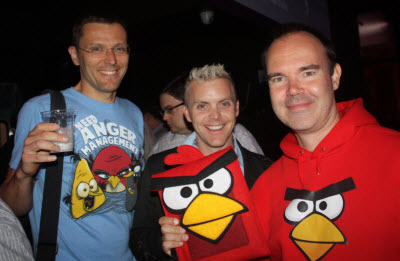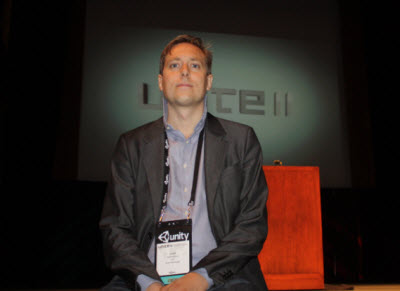 A growing number of game visionaries are saying a single game can reach a billion people. That idea has become a cause célèbre, providing a target for an industry that is expanding beyond its old boundaries.
A growing number of game visionaries are saying a single game can reach a billion people. That idea has become a cause célèbre, providing a target for an industry that is expanding beyond its old boundaries.
For skeptics who believe we’re in the midst of a gaming industry bubble, the idea is just more evidence of mass hysteria among game makers. But the believers say that they can see the stepping stones to the goal, and they’re all grounded in an achievable reality.
New platform technologies such as HTML5 and mobile devices, the growing popularity of gaming, a receptive mass market, cloud gaming and changing demographics could all make it happen in the not-so-distant future, said Peter Relan (pictured right), chairman of YouWeb, which has incubated four high-profile game startups.
Speaking at the jam-packed HTML5 Dev Conference (which drew 1,200 attendees to San Francisco this week), Relan said that HTML5 — the next lingua franca of the web — will enable cross-platform games, where you can write a game once and publish it across many different platforms. HTML5 games are slow and don’t take advantage of each new device’s unique capabilities yet, but the standard is being updated and supplemented with technologies such as Relan’s own startup, Spaceport, which has made an HTML5 rendering engine combined with Javascript.
“We want to create the game that reaches a billion people,” Relan said. “We sense that web 3.0 is here. Mobile devices will get to six billion people. They will become pervasive. We will have the ability as app developers to build apps that, with a push of a button, could update the user experience of a billion people, just the way that Google does when it changes its search theme for Thanksgiving.”
It might seem like a game that reaches a billion people would have to be really simple and unsophisticated. But Relan said, “We greatly overestimate what we can do with a technology in two years, and greatly underestimate what we can do in 10 years. We’ve reached an inflection point in technology. When the iPhone first came out, the most popular games were arcade games. Now they are free-to-play, social freemium games. HTML5 games will start out as arcade titles. Then they will evolve. The technology is here to be the great normalizer across the platforms.”
He added, “The mobile web is combining the internet’s universal access with what the iPhone brought us, the simplicity of the app. That combination has never happened before.”
 Zynga’s rapid growth on Facebook to more than 265 million monthly active users has inspired game companies to reach for a broader mass market. Facebook itself can’t yet deliver a billion users for one game, since the social network has only 800 million users. But if you take a game and publish it on Facebook, on Apple’s iPhone, on Google Android devices, and on web sites around the globe, it is possible to reach a billion users.
Zynga’s rapid growth on Facebook to more than 265 million monthly active users has inspired game companies to reach for a broader mass market. Facebook itself can’t yet deliver a billion users for one game, since the social network has only 800 million users. But if you take a game and publish it on Facebook, on Apple’s iPhone, on Google Android devices, and on web sites around the globe, it is possible to reach a billion users.
Back in July, Peter Vesterbacka (pictured left, on the right), the “Mighty Eagle” at Rovio, the maker of Angry Birds, argued that his company’s huge mass market game would be the big one.
“We want to be the first entertainment brand with a billion fans,” he said in a talk at the Casual Connect conference in Seattle. “That will take us two or three years to do.”
Already, Angry Birds has reached more than 350 million downloads, and it has become a recognized brand faster than just about any other cultural phenomenon. The simple bird slingshot game is played for more than 300 million minutes each day, and that is enabling the company to raise a round of funding that could value Rovio at more than $1.2 billion. “To get to the one billion fans, we will expand to all screens. The biggest platform for us is currently the smartphone (iOS, Android etc.), but we expect big growth on the web and also on lower-end phones,” Vesterbacka said in an email. Rovio is also expanding into the living room via initiatives like Angry Birds on the Roku2 box, and it is taking a multi-pronged approach to expanding in China.
“Facebook has 800 million users and they are not even in China, so reaching the billion should be pretty straightforward,” Vesterbacka said.
It’s a matter of removing obstacles to the expansion of the game industry and knocking down barriers that prevent a game from being distributed to the widest possible audience.
 “Everything is coming together,” said David Helgason (pictured right), chief executive of Unity Technologies, maker of the browser-based Unity game engine. “Our industry is making quantum leaps forward. The web is closing the gap with the console technologies.” Helgason’s game tools “democratize game development” by enabling game designers to turn out sophisticated 3D games.
“Everything is coming together,” said David Helgason (pictured right), chief executive of Unity Technologies, maker of the browser-based Unity game engine. “Our industry is making quantum leaps forward. The web is closing the gap with the console technologies.” Helgason’s game tools “democratize game development” by enabling game designers to turn out sophisticated 3D games.
These games will run as well on smartphones as they do on high-end computers. And they won’t be crappy. They will have some of the same high-end 3D graphics features and awesome storylines and characters as traditional console titles, Helgason said at the Unite 11 conference this week.
It’s not just the goofy new game leaders who are talking about a billion gamers. Traditional game companies have the same goal. John Riccitiello, chief executive of EA, said that the global video game community would soon top a billion players.
“A few years ago, I think there were a couple of hundred million consumer participants in our industry. I think we are going to break a billion in a year or two,” Riccitiello said in an interview with Reuters at the E3 video game conference in Los Angeles.
Zynga, meanwhile, the new arch rival of EA, has a goal of connecting the world through games, said Owen Van Natta, chief business officer at Zynga. It will do so by taking its popular Facebook games and spreading them across mobile devices and other platforms.
Venture capitalists are looking to fund game companies that have a very big vision for reaching the widest audiences. “My sights are set on the company that can create the billion-player game,” said Relan, an active game investor.
“There are really game-changing things that will happen when you can play games across all of your screens,” said Josh Elman, a former Facebook and Twiter product manager who is a principal at venture firm Greylock Partners. “We are looking at companies that can take massive advantage of these platforms and build something that is unique and defensible.”
In addition to HTML5 and Unity, other technologies such as Adobe’s upcoming Flash 11, the WebGL 3D gaming standard, Facebook’s Project Spartan for mobile phones, and other technologies will make it easier and easier to share high-quality experiences across more and more platforms at very low production and distribution costs.
 David Brevik (pictured left), president of Gazillion Entertainment, a maker of massively multiplayer online games, said in his speech at the Unite 11 conference that we could see a “Golden Age” of games return for developers and publishers. He points to console-quality browser games, no need to install anything, tablets and smartphones, cloud gaming. The stars are becoming aligned in networking, graphics, input systems, distribution, and business models.
David Brevik (pictured left), president of Gazillion Entertainment, a maker of massively multiplayer online games, said in his speech at the Unite 11 conference that we could see a “Golden Age” of games return for developers and publishers. He points to console-quality browser games, no need to install anything, tablets and smartphones, cloud gaming. The stars are becoming aligned in networking, graphics, input systems, distribution, and business models.
The internet has provided the reach to billions of people. High-quality graphics will soon become available on everything from Facebook to mobile phones, thanks to technologies such as fast mobile chips, 3D game tools such as Unity, Adobe’s Flash 11 and Air 3 technologies, and HTML5 combined with Javascript. Touchscreens are far easier as input systems. Distribution is becoming both cross-platform and viral. And the free-to-play business model — where users play for free and pay real money for virtual goods in small transactions — is able to enlist more and more new gamers.
“This is very exciting,” he said. “You have to ask, ‘what would Nintendo do with this?'”
VentureBeat's mission is to be a digital town square for technical decision-makers to gain knowledge about transformative enterprise technology and transact. Learn More
